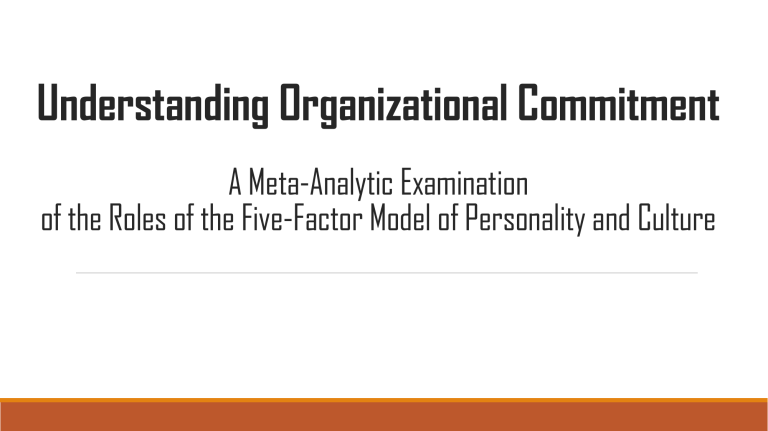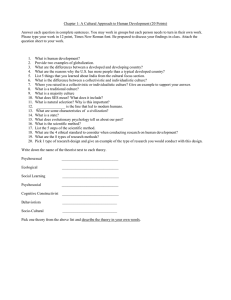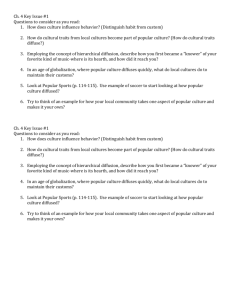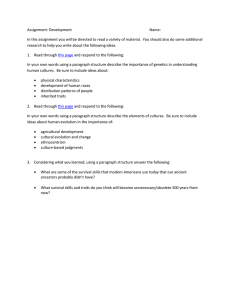
Understanding Organizational Commitment A Meta-Analytic Examination of the Roles of the Five-Factor Model of Personality and Culture 1. What are dispositional antecedents of OC? 2. What is the role of FFM of Personality (as a whole) on commitment? Questions 3. Whether the relationship between FFM and organizational commitment vary across national culture (moderating role) Dimensions of FFM Traits 1. Emotional stability (Neuroticism) 2. Extraversion 3. Openness to experience/ intellect 4. Agreeableness 5. Conscientiousness Forms of commitment Psychological bond with an organization characteristic adaptation that is influenced by the interaction of traits and situational factors Meyer and Allen (1991, 1997) differentiated three forms of commitment: 1. affective commitment (AC; an emotional attachment to the organization) 2. normative commitment (NC; a felt obligation to remain with the organization) 3. continuance commitment (CC; commitment based on the costs and benefits associated with leaving the organization). H1: Emotional Stability is (a) positively related to AC and (b) negatively related to CC. H2. Extraversion is (a) positively related to AC and (b) negatively related to CC. Hypotheses H3: Openness to Experience is negatively related to CC. H4: Agreeableness is positively related to (a) AC and (b) NC. H5: Conscientiousness is positively related to (a) AC and (b) NC. The Moderating Role of Culture 1. Individualism versus collectivism 2. Useful dimensions in understanding the influence of social context on attitudes and behavior 3. The characteristics of collectivistic cultures (interdependent self, interpersonal relationships, and normative pressures) provide trait-relevant situational cues that trigger the expression of three of the FFM traits: Emotional Stability, Agreeableness, and Conscientiousness. (Based on Trait Activation Theory) H6: Emotional Stability is (a) more strongly and positively related to AC and (b) more strongly and negatively related to CC in collectivistic cultures than in individualistic cultures. Hypotheses (cont’d) H7: Agreeableness is more strongly and positively related to (a) AC and (b) NC in collectivistic cultures than in individualistic cultures H8: Conscientiousness is more strongly and positively related to (a) AC and (b) NC in collectivistic cultures than in individualistic cultures. 1. Defining research subject and questions 2. Choose Initial resources based on a structured frame 3. Examining resources’ scientific value 4. Extracting information Steps to Meta Analysis 5. Statistical analysis 6. Discussion over results Here : the authors used Hunter and Schmidt’s (2004) psychometric meta-analysis method •Electronic databases in applied psychology • Search with a combination of keyword representing personality and commitment Identification of Primary Studies •Reference sections of relevant meta-analytic studies and review papers •Searching for possible unpublished/working and in-press studies •First: only primary studies based on employee samples from work organizations Inclusion Criteria •Second, primary studies which measured one of the FFM traits with measures explicitly developed to measure the FFM traits (e.g., the NEO-PI-R, the NEO-FFI, the IPIP, the BFI, … all FFM traits included in the current meta analysis are comparable in terms of measurement/construct • Third, primary studies assessing at least one of the three forms of organizational commitment (AC, NC, and CC) . •Fourth, primary studies that reported enough information to calculate the correlations between FFM traits and organizational commitment •Two authors independently coded all the relevant articles •To verify coding accuracy: Coding Procedure and Accuracy • the effect sizes, sample sizes, reliability estimates, FFM measures, forms of organizational commitment, and publication status were compared. •The interrater agreement rate was high at 98.9% 50 studies 55 independent samples N: 18,262 Correlation coefficient Reliability Comparison index correlation coefficients were corrected for unreliability in both independent and dependent variables using local reliability estimates reported (in all cases, coefficients alpha) Variability of the corrected correlations calculating 80% credibility intervals (CVs) Points for interpreting the result table 80% Credibility intervals (CV): If the credibility interval around a positive average correlation excludes zero, this suggests that at least 90% of the individual correlations included in the metaanalysis are positive and thus the relationship is generalizable in most cases. 95% Confidence intervals (CI); if these intervals include zero, this suggests that the mean truescore correlation does not differ from zero. To test the moderating role of culture, authors conducted the independent sample z test with mean true-score correlations H1: Hypotheses 1a and 1b were both supported. Notice: 80% CV for the relationship between Emotional Stability and CC included zero, indicating that more than 10% of the individual correlation coefficients in this meta-analysis were positive. Hypotheses H2. Hypothesis 2a and 2b were also supported. Notice: Extraversion–CC relationship is weak and its 80% CV included Zero, indicating that the negative relationship is not always generalizable; more than 10% of the individual correlation coefficients in this meta-analysis were H3: was supported. Notice: its 80% CV included zero, indicating that more than 10% of the correlation coefficients in this metaanalysis were positive. Hypotheses H4. Hypotheses 4a and 4b were both supported; The true-score correlations of Agreeableness with AC and NC were in the hypothesized direction and significantly differed from zero. H5: Hypotheses 5a and 5b were both supported. For informational purposes; All of the FFM traits were positively correlated with overall/attitudinal commitment and significantly differed from zero. H6: Emotional Stability was slightly more strongly and positively related to AC in collectivistic cultures than in individualistic cultures, but they are not significantly different (z= 0.48). Hypotheses (cont’d) Emotional Stability-- CC was slightly stronger in collectivistic than in individualistic cultures, but again the difference was not significant (z= 0.13). H7: Authors found support for both Hypotheses 7a and 7b. H8: Although Conscientiousness was slightly more strongly and positively related to AC and NC in collectivistic cultures than in individualistic cultures, the differences are not statistically significant; z = 1.45 (for AC) and z =0 .98 (for NC). Thus, Hypotheses 8a and 8b were not supported. FFM traits explained more variance in AC and NC in collectivistic cultures than in individualistic cultures. That is, the FFM traits were found to be more useful in determining or predicting organizational commitment in collectivistic cultures than in individualistic cultures. Implication 1. the FFM traits as a whole are significantly associated with three forms of organizational commitment and more strongly in collectivistic cultures than individualistic cultures 2. findings underscore the role of Agreeableness in shaping organizational commitment. Agreeableness was the strongest predictor of both AC and NC. The importance of Agreeableness is that Agreeableness plays a critical role in understanding organizational citizenship behaviors , turnover and counterproductive workplace behavior 3. practitioners will benefit from considering all of the FFM traits in their selection systems. Limitations 1. Is Mayer commitment measure a true measure yet? 2. Other personality traits can influence OC too. 3. There are certainly other situational moderators that may affect the relation between FFM and organizational commitment. 4. They just consider moderating role of Culture on some dimensions of FFM. 5. They consider just one comparison point: correlation coefficient 6. In some cases they substitute correlation coefficient with composite correlation coefficient 7. some correlations were estimated based on a small number of primary studies 8. Understanding their article needs higher level of statistic knowledge which make it almost incomprehensible for managers and practitioners with a lower level of statistical knowledge 9. The cross sectional nature of the data in almost all primary studies included prevented the examination of causal relationship. 10. They did not consider the role of culture on openness to experience and agreeableness but in their final result they mention all of them Thanks for your attention







